Water / Soil / Ground Environment
State of Japan's Environment at a Glance: Japanese Lake Environment - A Solution with Multiple Measures Quality
A Solution with Multiple Measures
There is no single all-powerful solution for lake conservation. The Plan for Conservation of Lake Water Quality consists of several countermeasures. A new focus on measures for non-point sources of pollution, e.g., agricultural sources, is needed in addition to the existing measures for point sources to halt the progress of water pollution. In particular, some non-point sources, such as storm water, have not been effectively managed by existing measures.
Basin Management Measures
Sewerage System Installation
Fundamental to basin management measures is the installation of sewage systems. Sewage systems are required in the watershed of nearly all natural lakes located in populous areas. The growth rate of the population supported by the sewage system serving Kasumigaura Lake has increased from 10.9% in 1980 to 33.4% in 1992 (the growth rate is predicted to reach 58.3% [approx. 600,000 people] by the year 2000). The growth rate for the population supported by Suwa Lake for the five-year period between 1992 and 1997 has leveled out at the high level of between 68% and 81%.
Breakdown of the Nutrient Load Flowing into Suwa Lake
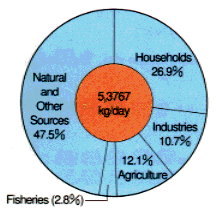
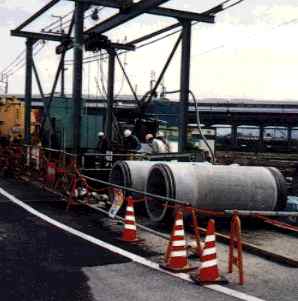
Basin Area Sewage System (under construction)
Small-scale Wastewater Facilities for Rural Communities (Rural Sewerage Systems)
Providing low-density population districts with large-scale sewage systems is costly. Therefore, the installation of small-scale sewage systems is being promoted for small rural villages. Some examples of these systems are found in the catchment areas of Nojiri Lake, Kojima Reservoir, Shinji Lake, and Nakanoumi Lake.
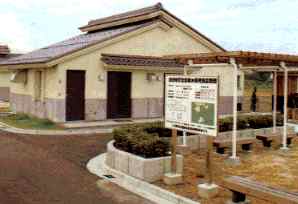
Small-scale Sewage Treatment Plant
Integrated Septic Tank Treatment System for Domestic Wastewater
Integrated septic tank treatment systems are desirable in places where there are no sewage systems. The integrated septic tank treatment system treats multiple sources of household wastewater (kitchen wastewater, bath wastewater, etc.) and can considerably reduce the volume of the discharged pollutant load (about one-eighth) compared to the single septic tank treatment system, which only treats excrement. Many municipalities have established subsidies to promote this integrated septic system. Even the mountain huts near Ozenuma Lake have integrated septic tank treatment systems. Examples of this system can be found in the catchment areas of Kahoku-gata Lake, Sagami Reservoir, and Biwa Lake.
Measures for Wastewater Discharged from Factories or Establishments
The quality of corporate wastewater has been strictly regulated by effluent standards, but stricter effluent standards are being applied recently because of the inclusion of small factories and other facilities not conventionally covered by these measures. In addition to manufacturing plants, hotels and laundry services will also be subject to these measures. Furthermore, a majority of prefectures are establishing independent standards, stricter than national regulations, to cope with their own particular situations.
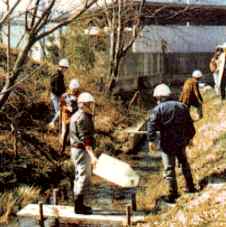
Firefly Habitat Zones near
a Factory along a Drainage Canal
Measures for Agriculture, Livestock and Fishing
- Agriculture:Silt and fertilizer are discharged into the water stream when rice paddies are planted. To curb this pollution load, farmers are educated on the appropriate use of fertilizers. Subsidies are also provided to purchase mechanical fertilizers to achieve optimal fertilizer application, which in turn enhances water circulation so water can circulate from drainage canals into supply canals. Examples of the results of this policy can be found in the catchment areas of Abashiri Lake, Kamafusa Lake, Kasumigaura Lake, Kahoku-gata Lake, Mikata Lake, Nojiri Lake, Nakanoumi Lake, and Shinji Lake.
- Livestock:Excrement from livestock, e.g., pigs, is a large pollution load. Grants are provided to help install livestock excrement treatment facilities, and guidance is available for appropriate livestock management and fertilizing arable land with excrement from livestock. Examples of the results of this policy can be found in the catchment areas of Abashiri Lake, Kamafusa Lake, Kasumigaura Lake, Toyano-gata Lake, Kahoku-gata Lake, Shibayama-gata, Nakanoumi, Shinji Lake, and Kojima Reservoir.
- Fisheries: Efforts are being made to transfer the carp farming areas in Kasumigaura Lake to another location outside of the lake, and the use of low-protein improved fodder is being promoted. Examples can be observed in catchment areas of Kasumigaura and Shoji Lakes.
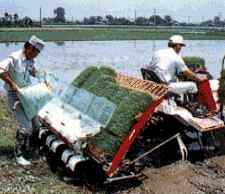
Rice Transplanter with Fertilizer Applicator
In-Lake Cleaning Measures
Diversion
Treated sewage is discharged outside of the lake (e.g., Shikotsu Lake, Toya Lake, Akan Lake, Abashiri Lake, Towada Lake, Tazawa Lake, Unagi-ike Lake, etc.).
Water Conveyance (Dilution)
Clean water is conveyed from rivers to lakes (e.g., Toyano-gata Lake, Yogo Lake, Jinzai Lake, etc.).
River Water Improvement
Water purification facilities are being installed on inflow waterway beds of lakes (e.g., Toya Lake, Toyano-gata Lake, Suwa Lake, Aburaga-fuchi Lake, Biwa Lake, etc.). In particular, equipment to counteract mineshaft water seepage was installed at Toya Lake, and equipment to neutralize acid water inflow was installed at Tazawa Lake.
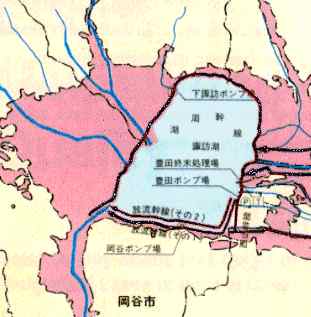
Suwa Lake Basin Sewage Works Preventing Treated Water from Entering the Lake
Promotion of Aeration and Water Circulation
Many artificial lakes are being fitted with fountains to decrease plankton through aeration (e.g., Kamafusa Lake, Takataki, Sagami Reservoir, Tsukui, Agigawa and Habu, etc.). Also, air is bubbled from the bottom of lakes at intervals to circulate the water at the bottom to the top, and stirring pumps are used to create convection currents in the water mainly in artificial lakes (e.g., Yogo Lake, Sagami Reservoir, and Sengari Reservoir, etc.).
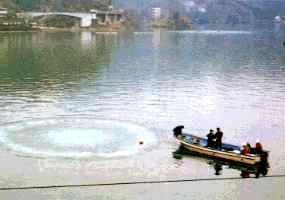
Intermittent Water Convector in Sagami Reservoir
Managing Water Weeds, Water Bloom, and Algal Bloom
Biwa Lake was plagued by a second large outbreak of Elodea (a small, grass-like plant) in the latter half of the 1980s and more recently by large amounts of duckweed. The duckweed is collected by a special craft during the reproduction season in July and August. Annually, 240 hectares of water chestnut are harvested at Inba-numa Lake (also harvested at O-numa Lake, Abashiri Lake, Suwa Lake, etc.). Kasumigaura Lake is protected from water bloom entering from Tsuchiura Bay with fencing and collection by boat. Algal bloom is collected by boat and burned at Kazaya and Futatsuno Reservoirs. Furthermore, there is an increase of reservoirs that can draw water both at the surface and below the surface so that clean water can be drawn when there is excessive reproduction of plankton at the surface layer.
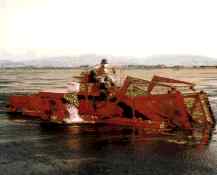
Biwa Lake Water Weed Collection Craft
Dredging
Dredging occurs in many lakes to reduce nutrients that accumulate in sediment. Dredging varies from small-scale projects around household effluent inflow areas to large-scale projects such as the 25-year plan to dredge eight million cubic meters of Kasumigaura Lake. Lakes being dredged include O-numa Lake, Akan Lake, Harutori Lake, Abashiri Lake, Kasumigaura Lake, Yuno , Tega-numa Lake, Kameyama, Sagami Reservoir, Toyano, Shibayama-gata, Kitagata, Mikata-goko Lake, Suwa Lake, Biwa Lake, Sengari Reservoir, Koyama-ike, Togo-ike Lake, Jinzai Lake, Kojima Reservoir, and Tokiwa .
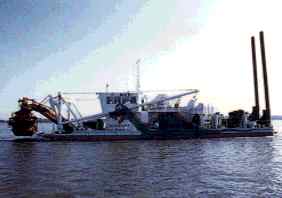
Dredging Boat on Kasumigaura Lake
Ecosystem Conservation
Shiga Prefecture enacted the Ordinance on Conservation of Reed Beds in Lake Biwa in 1992 to ensure habitat for fish and waterfowl, protect the natural scenery and water quality, and prevent lakeshore erosion. An all-out effort is made to cultivate reed colonies as well as protect them in designated areas. Reeds and water hyacinths are also used for water cleansing experiments in other lakes. A sanctuary has been established at Izu-numa Lake where wild oats are cultivated to use as waterfowl feed. Examples of these kinds of ecosystem conservation efforts can be observed at Harutori Lake, Izu-numa Lake, Inba-numa Lake, Tega-numa Lake, Nojin Lake, Biwa Lake, and Sugano Lake.
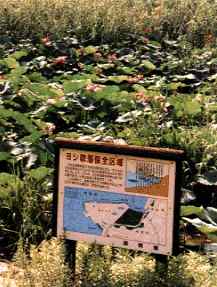
The Shore of Biwa Lake Protected in Accordance with the Ordinance on Conservation of Reed Beds